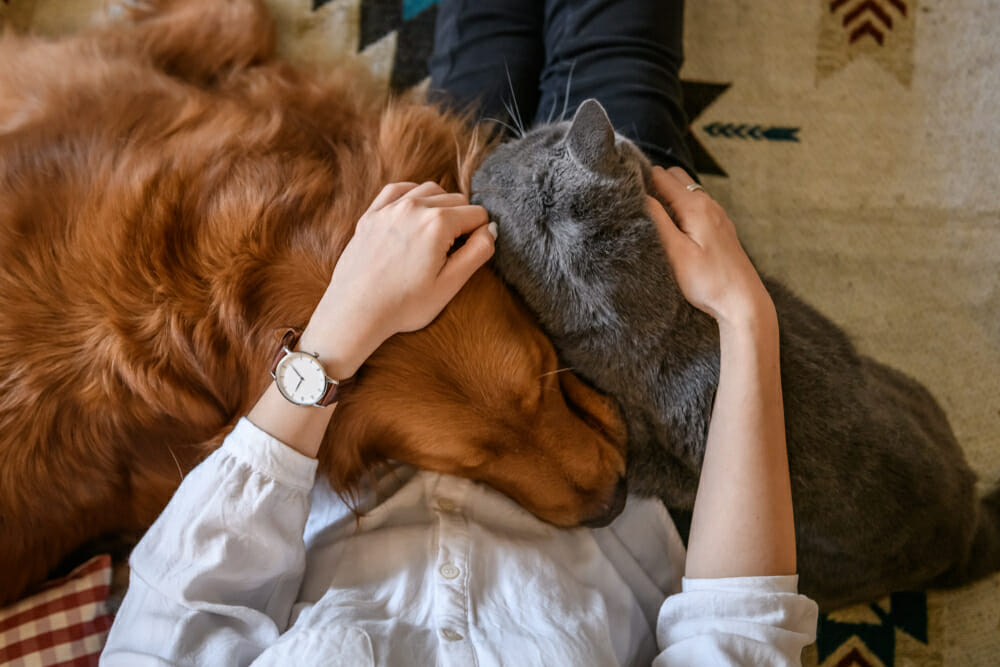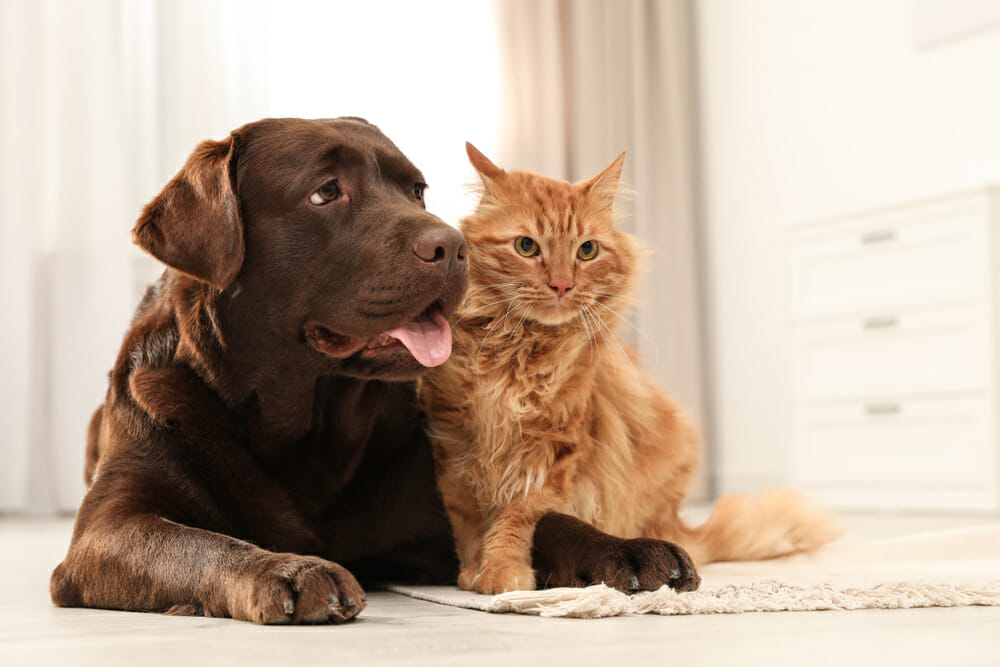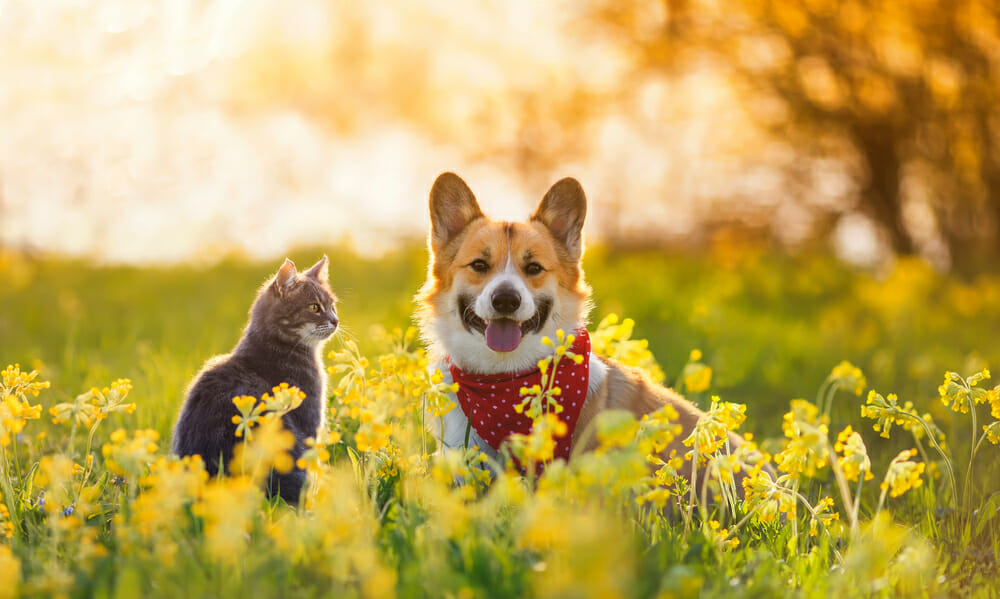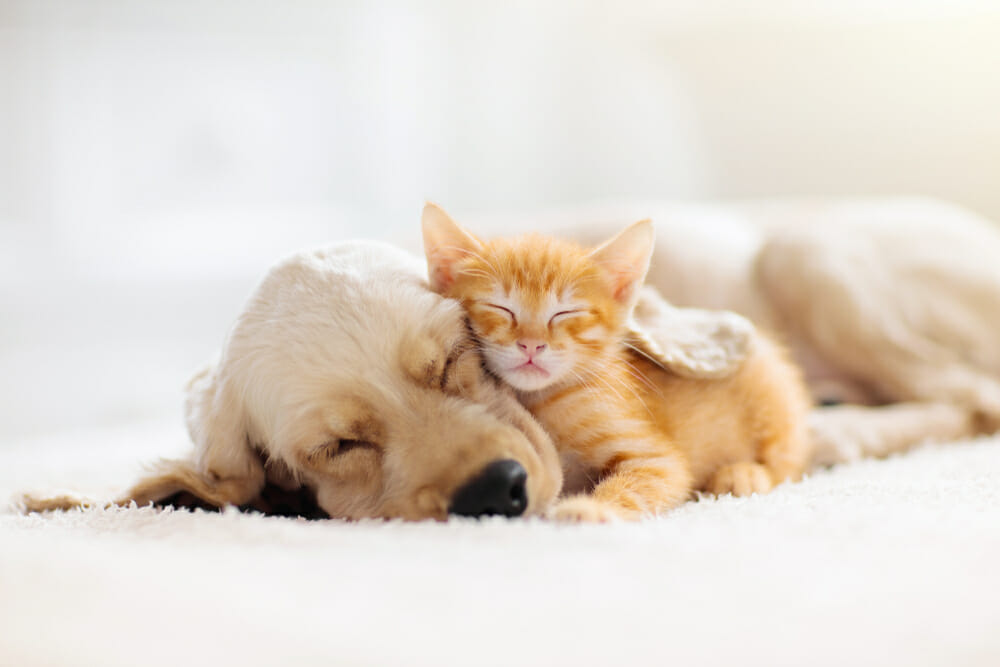Wondering if you can raise a cat and dog together? Or how to introduce your possibly-anxious cat to your dog? We’ve got some tips for you!
Raising a Cat and Dog Together
If you’re nervous about raising a cat and dog under the same roof—don’t worry, it can be done! Although we’ve all heard the expression “fighting like cats and dogs,” these two animals can most certainly be friends.
One of the easiest and best ways to ensure this is by starting with a puppy and kitten at the same time. If they grow up together, they will be more likely to bond, and their home situation will seem completely normal.

Take their personalities into account.
If you’re bringing a new cat home to your dog, or vice versa, it’s much more important to consider each of their personalities, rather than worrying about their breeds. Any well-socialized animal can get along with another.
Before we jump into the tips on how to best introduce them, keep these warning signs in mind.
Warnings Signs:
- Your dog is overly focused on your cat, or lunges as soon as your cat moves.
- Your dog or cat jumps, growls, or snaps at the other while they’re being calm, quiet, and still.
- One or both animals stops eating, drinking, having healthy bathroom habits, or begins to hide from family members. These are signs that they are unhappy.
How to Introduce a Scared Cat to a Dog
There are lots of ways to make the introduction of a new pet smoother and more enjoyable for everyone.
1. Train your dog.
It’s important that you work with your dog to help them understand the basics like sit, lie down, and stay. These will be crucial when it comes to keeping your dog calm around your cat. This will keep your dog more focused on you when the three of you are in the room together, and ease the transition.

2. Give a cat their own safe space.
Your cat will need their own territory. Not only for them to have some solo time on a daily basis, but also to give them a space of their own while they adjust to the newcomer. That’s because it’s a good idea to keep your cat and dog apart at first, so your new pet can adjust. It’s helpful to give them breaks from each other throughout the entire introduction process.
3. Exercise your dog’s mind & body.
Dogs can get overly excited very quickly. And in most cases, dogs are bigger than cats. Their larger stature and high energy can come across as a threat to your cat. Set them both up for success by giving your dog plenty of physical and mental exercise to get that excess energy out in a productive way.
4. Keep their toys and food separate.
Pets can get pretty protective of their things. So keeping your dog and cat’s food and toys separate from each other will help avoid any unnecessary fighting. With that said, letting them sniff one of the other’s toys to get used to the scent can be beneficial in the long run. But we’re not sure how much dogs like catnip, anyway.

5. Supervised meeting in a safe space, on-leash.
For their first interaction, make sure it’s in a quiet, safe space. Keep your dog on a harness and leash, so you can control them better. And having another family member or friend around to hold the cat—in their arms or on a leash will help control your cat calm as well.
6. Let your cat run.
If your cat gets scared and wants to run away, let them! You don’t want to risk traumatizing your cat by forcing them to stay put in a scary situation. This doesn’t mean that all hope is lost. It just means that your pets need a break (who doesn’t sometimes?), and that you can try again later.
7. Keep the mood positive.
It’s important that you stay calm, cool, and collected to help make this introduction a positive experience for both pets. If you scold your dog for barking at the cat every time they’re together, your dog will associate time around the cat with scolding. So make sure to use lots of positive reinforcements, like treats and pets!
8. Use a baby gate for safe interactions.
Whether it’s for the initial interaction, or continued interactions… your cat and dog can safely get to know each other through a baby gate. They can get close, see and sniff each other, and still feel safe because neither pet can attack the other. And remember—you may need to double stack the baby gates if you have a bigger dog, or you think your cat will jump the gate.
9. Be patient.
Some pets might get along right away, and others will take some time. But the majority of pets can learn to get along. It just takes time, and every situation is unique.

10. Allow unsupervised interactions.
Once you think it’s safe, and they’re both ready, you can start letting your cat and dog interact unsupervised s. You might want to start with shorter interactions, and build up to longer periods of time from there.
How Long Does it Take for a Dog to Get Used to a Cat?
While there are rare cases where the pairings don’t work out, in most situations, these two animals can and will learn to live together and get along.
Depending on their personalities and previous experiences with the other species, it’s possible for some cats and dogs to start getting along within just a few hours. However, it’s completely normal for this process to take several days.
Even if you’ve had your cat and dog for quite a while, and you wish they would actually bond—you can use our tips above to “re-introduce” them to each other. Little by little, you can help your cat and dog actually bond and get along.
Looking for other pet parenting articles?? We’ve got you covered!




















